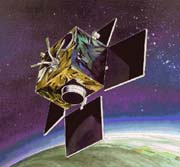Astrid
 Sweden's third scientific satellite and first microsatellite, ASTRID carries an Energetic Neutral Atom analyzer, an Electron Spectrometer and two UV imagers for imaging the Earth's aurora. Astrid was piggyback launched with the Russian Tsikada navigation satellite and FAISAT, a small store-and-forward communications satellite. Astrid's scientific instruments went into full operation on Feb 6, after the satellite started getting eclipse periods on every orbit. During a month of operation, 20-30 hours of data were collected over 150 orbits. On March 1, a DC/DC converter for all the three instruments failed to switch on, preventing further scientific operations. However, the satellite proved to be a useful testbed in subsequent months for store-and-forward communications and for autonomous sun-pointing software algorithms.
Sweden's third scientific satellite and first microsatellite, ASTRID carries an Energetic Neutral Atom analyzer, an Electron Spectrometer and two UV imagers for imaging the Earth's aurora. Astrid was piggyback launched with the Russian Tsikada navigation satellite and FAISAT, a small store-and-forward communications satellite. Astrid's scientific instruments went into full operation on Feb 6, after the satellite started getting eclipse periods on every orbit. During a month of operation, 20-30 hours of data were collected over 150 orbits. On March 1, a DC/DC converter for all the three instruments failed to switch on, preventing further scientific operations. However, the satellite proved to be a useful testbed in subsequent months for store-and-forward communications and for autonomous sun-pointing software algorithms.
Spacecraft
Spin stabilized, controled with magnetic torquers and a nutation damper. Spin up was accomplished with a small solid rocket thruster. A flux-gate magnetometer and solar aspect sensor provide attitude sensing. Four solar panels provide roughly 20W of power to the payload, spacecraft bus, and for charging 2 NiCd batteries. Data processing is handled by an 80C31 processor with 8MB of memory available. Downlink occurs via S-Band (2208.629 MHz) at 131 kbps or via 400.55 MHz at 8kbps. Transmitter power is 2W. Commands are uplinked in the 449.95 MHz band at 4800 bps. Astrid is controlled from Swedish Space Corporation's ground station at ESRANGE in Kiruna.
Payload
Astrid's scientific payload was developed by the Swedish Institute of Space Physics in Kiruna. The main instrument is a Neutral particle imager, or PIPPI (Prelude in Planetary Particle Imaging). The operation of PIPPI in orbit was the first time a dedicated instrument has been used to measure neutral particle flux from the ring current. An Electron Spectrometer, EMIL (Electron Measurements - In-situ and Lightweight) whjich measures electron distribution at 62.5 ms or 125 ms resolution. Two UV imaging photometers, MIO (Miniature Imaging Optics), are mounted in the satellite spin plane. One observes Lyman alpha-emission from the Earth's geocorona, the other observes auroral emissions.
| Country of Origin | Sweden |
| Customer/User | Swedish Space Corporation (SSC) |
| Manufacturer(s) | Swedish Space Corporation (SSC) |
| Size | 290mm x 450mm x 250mm |
| Orbit | 966 km x 1026 km inclined at 82.93 degrees |
| Related Sites | Astrid Web Page |
Launch Facts
| Name | Int'l Desig. | Date | Site | Vehicle | Orbit | Mass(kg) |
| Notes | ||||||
| Astrid | 1995-002B | 1/24/95 | Plesetsk | SL-8 | LEO | 27 |
| Auroral plasma and auroral imaging. DC-DC converter failure halted scientific operation on March 1, 1995. However the satellite was used in subsequent months for technology and communications concept validation and testing. | ||||||
Information in The Mission and Spacecraft Library is provided without warranty or guarantee. USE AT YOUR OWN RISK.